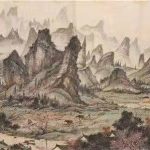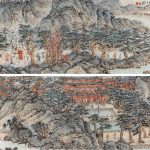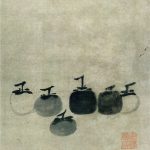Lin Haizhong 林海钟, discourses on Chinese painting
Issue 3 – Curator; Giacomo Bruni
Lin Haizhong, other names include, ‘Master of the Rivers and Stream Pavilion’ 林泉阁主人, ‘Man who lies in the Red Mountain Clouds’ 卧霞山人, is currently a full time professor of Chinese Mountain and Water Painting in the department of Chinese Painting and Calligraphy at the China Academy of Art in Hangzhou 中国美术学院. In addition to being a highly accomplished and recognized artist, Haizhong also serves as Supervisor to both Masters and Doctoral students of the Academy. Lin Haizhong is deeply focused on fostering and passing down the authentic tradition of Chinese Painting. Further, he also searches to find new meaning in its use and development. His work presents an expression of the ancient meeting contemporary consciousness. In addition, his paintings establish a realm that is both unadorned with ancient simplicity, quietness, caracterized by raw and spontaneous movement. His works also breathe an expression of the current day. There is an endless aesthetic joyfulness and boundless power to his works’ spiritual achievement.
谈 “传移摹写”
On Chuanyi moxie The Method of “Transmission and Copying”
如何来认识绘画?绘画到底是什么?虽然我一直在中国美院从事教学与绘画实践,学画也差不多有近30年的时间了,好像学了很多东西,如技法、画史、画论等等,但仍然不太明白。这几年回过头来,回到最根本的问题:绘画到底是什么?中国画是怎么回事?山水画是怎么回事?学生们也经常问:“您怎么看中国画?好的中国画用什么标准评判?”。这些问题都是特别朴素的问题,但是有时候我真的一下子不知道怎么去回答。前段时间,我给学生讲临摹,讲到绘画“六法”里面的“传移摹写”,很有感触,觉得很多最朴素的问题在“六法”的“传移摹写”中已经说清楚了。以前我只把“传移摹写”理解成临摹的概念,要学习绘画,中国人是从临摹先人作品开始的,临摹是学习绘画的捷径。但是现在说“传移摹写”就是临摹,就没那么简单了,应该有更深刻的含义在里面;但是我以前没有留意到。
How do we understand the act of painting? What exactly is painting? I have been engaged in teaching and painting practice at the China Academy of Art for almost 30 years. It would appear that I have learned some things along the lines of technique, painting history, and theory. However, I still don’t have quite a clear picture. Looking back over the past few years, I return to the most fundamental questions: What is painting? What is Chinese painting? What is Mountain and Water (Shanshui) painting? Students often ask me such questions, “What is your understanding of Chinese painting? What kind of criteria should one use to judge a good Chinese painting?” These are elementary and straightforward questions, but sometimes I genuinely do not know how to answer them! Some time ago, I taught my students about linmo 临摹 (the practice of observing and making close studies from masterworks). In discussing this subject, I spoke about the concept of Chuanyi moxie 传移摹写 (transmitting and copying or imitating) discussed in Liufa 六法 the “Six Methods” or “Procedures.” This gave me an epiphany. I realized that many of the issues I sought to understand had already been clarified in this fundamental principle. In the past, I only understood “transmitting and copying” as to mean the act or practice of copying. In China, when learning to paint, one often starts by copying the works of his or her ancestors. Copying is seen as a shortcut to learning painting. However, now in thinking about the term “transmitting and copying,” I believe it is not that simple and has a deeper meaning, but I hadn’t paid attention before.
首先说 “传”
“传”的意味很深刻。起初,我觉得“传”就是学习临本,其实不尽然。“传”应该是传统, 是规律。形式上可能就是古画本,实际在其中传递着绘画之道。传统是什么是?是绘画规律,是品格,是认知,是古人与道的契合。什么东西能够流传下来?就是古人的真知灼见,或者说是他们对于山水的最根本的知见,这是我们后人应该“传”的。比如说“六法”中,“骨法用笔”是绘画的规律,是可以传的;“气韵生动”也是“传”,“六法”本身就是“传”。
“Transmit” chuán 传
“To Transmit” in this sense has a very profound meaning. Initially, I thought that chuán meant to learn from copying the original paintings, but this is entirely false. Chuán refers to ‘passing down a continuous system‘ and to ‘laws.’ In terms of the form this might take, it may just be an ancient painting, but what such a painting actually conveys is the method of painting. What is Chuantong (often translated as ‘tradition,’ but literally meaning, passing down a continuous system, “pass” 传 and “unify” 统)? It refers to the painting’s rules and order, quality or character, underlying consciousness, and the link between the ancients and the path to higher understanding. What can be passed down? It is the profound wisdom and insight of the ancients or their most fundamental knowledge concerning depicting mountains and waters. These aspects are what we as descendants should “pass” or continue to transmit down to our posterity. For example, “the ‘Bone Method’ of using the brush” 骨法用笔. This represents a rule or procedure of painting that can be transmitted; “[Engendering] a sense of Spirit Consonance” 气韵生动 is also a means of chuán or passing down. Finally, the “Six Methods” themselves are also such a heritage that can be transmitted or passed down, chuán.
其次说 “移”
古人这个“移”字用得好,其妙无穷。“移”是移情,是方法什么东西能够让你移情,因为这个传统太好了,“移”能让学画者真正地进入传统,与它相应,并得到传承,太妙了我曾经和朋友聊到一个日本人,他是京都艺术大学古画复制专业的教授。我跟他聊天,听他说得很精彩,对我很有启发。他说单纯地复制古画是很没有意思的,但是能和古代作品相融合,那是一种享受。他复制古画的时候,从里面发现了很多新的东西。他说摹古不是那么简单的,照着样儿把它临下来,这里面非常有意思。他说得很陶醉,我觉得他得了“传移摹写”的真谛。好作品的确能够让人移情。当时,我想到了曾经读到过的一段关于学琴的故事:老师对学生说,“我教不了你了,我去把我的老师请出来教你。”然后把学生带到海边,老师就划着船出去请他的老师了。第一天没有回来,第二天还是没有回来,到第三天的时候,学生面对大海开始出现“移情”的状态,再弹琴的时候突然就开悟了;其实这种移情是古代非常重要的学习方法。传统对于我们来说是一个谜。用移情的方法去感知、去参求,是有可能与之契合的,这个方法很妙。所以,我当时读了故事就很有启发,因为道出了能够言说的,更有一种不能言说的东西道不出来,那用“移”的方法来学习,这真是我们古人的智慧啊。

“Shift, Move” yí 移
The ancients used the word yí well, and it is certainly a term that encourages endless consideration. Yí is empathy 移情. It is a method or means that can make one empathize. For example, because this tradition is so excellent, the concept of yí allows painters to truly enter into the practice, corresponding to it and inheriting and transmitting it themselves. It is marvellous. I once spoke to a Japanese friend, who is a professor specializing in painting reproductions at the Kyoto University of Art. We chatted, and I listened to his brilliant story and was very inspired. He said that simply copying ancient paintings is extremely meaningless, but harmonizing oneself with ancient works is a kind of enjoyment.
When he used to copy ancient paintings, he found many new things in them. He said that copying the ancients is not as easy as it seems, and it is significant to copy the works of the ancients down precisely as they are. He spoke in an intoxicating manner, and I believe that he has found the true meaning and essence of “transmitting and copying.” Good works can indeed engender empathy. At that time, I thought of a story that I once read about a student learning how to play the qin 琴. The teacher said to his student, “I can no longer teach you. I will ask my teacher to teach you.” Then he took the student to the beach and took a boat to ‘go get’ his teacher. However, on the first and second day, he did not return. By the third day, the student, facing the sea, began to “empathize” with the situation, and when he played his instrument again, he suddenly became enlightened. In fact, during ancient times, this empathy was an essential learning method. Tradition is very elusive to us. However, it is possible
to use empathy to perceive and participate and align oneself with it. This method is profound. So, when I read this story, I was inspired because it told me that some things can be put into words. But more things cannot be put into words and expressed. For this reason, it is vital to use the method yí to learn. This is really the wisdom of our ancients.
再次说 “摹”
“摹”就是传统感召之下的心摹手追。其实摹写的过程即是一个印证的过程,达到心手相印。学到的东西,时而习之,能有部分相契合,契合之处就是我们得到处,不亦乐乎。“传移摹写”是学习中国画的心法;当你能够心摹手追,去感知所学并与之相呼应的时候,当你能够运用“传移摹写”的心法时,你的心得也就自然而然流淌出来了。
“Copy” mó 摹
Mó is the diligent process of imitation under the guidance and calling of tradition. In fact, copying is a confirmation process, reaching the mutual trace of the mind and the hand. When we learn, we must constantly put what we have learned (intellectually) into practice. If we can do so, even if only in a small part, we will find great satisfaction in that small art of implementation. “Transferring and copying” represent parts of the most direct method, Xinfa 心法, of learning Chinese painting. When our mental observation can finally align with our hands, we will find harmony with all that we have learned. When we can use the method of Chuanyi moxie “transmitting and copying,” directly, all that we have learned will naturally flow out.
最后说 “写”
中国画讲究“用笔”,这一点在其他画种里都没有涉及,这反映了中国画的高度。中国人讲究用笔是抓住了绘画的关键,是将开启画道之门的钥匙紧紧地抓在画者手里。而西方人对于用笔的理解只是停留在“笔触”的概念。中国人认为画是因笔而成的,提出“骨法用笔”,这对笔法的提出,又是一个高度。中国人认为画画必须要懂得笔法,甚至认为画画是有笔顺的,就像写字那样是有笔顺的,一幅画的笔顺和气象代表了画家的生命气象,这是非常高妙的认识。西方人很晚才认识到绘画“笔触”的美感,特别是印象派,但是还远没有达到我们古人的这种认知高度。而中国古人对画中气韵的认知就更高了。
综上所述,我认为,以“传移摹写”的方式去承接传统的气脉很重要,是很重要的学画方法中国的中医和武学都是有传承的、而中国的书画传承在什么地方?好像断了一样,传统成为未解之谜,需要我们去参悟。如何来参?有很多方法,各有心得。我论说传承,讲“传移摹写”,并不是否认创新,只是不去专门谈论这个问題,因为不能和绘画之道真正契合来谈“创新”,其实都是空谈。不管是“师古人”或者“师造化”、“师己心”或者“创新”,都是我们的传统,都是方法和途径,并不是我们的目的;我们的目的是如何通过这些途径真正地明白和印证绘画之道,传承和接续先人的文脉。我希望将来我们的同行朋友和不同行朋友,都是同道,希望我们能有一天通达了,开阔了,明白了,悟道了,成为真正的和大道相契合的人。
“Write, depict” xiě 写
Chinese painting requires a careful study of learning to use the brush 用笔, which is absent in other painting traditions. Such a fact reflects Chinese painting’s sophistication. Chinese people reckon that achieving good brushwork is to grasp the crux of painting. It is like holding a key firmly in your hands. However, in the western canon, understandings of brushwork only care about “the mark.” Chinese believe that paintings are made by the brush and propose using “the ‘Bone Method’ in one’s brushwork. This represents another point of sophistication. Chinese believe that to paint, it is fundamental to understand the use of the brush, and even believe that painting has to follow stroke order, just like writing characters. The stroke order and atmosphere of a painting have a direct correspondence to that of a painter. This is a very nuanced understanding. In the West, the realization of the beauty and significance of “the mark” made via the brushstroke in painting happened very late. More particularly, this was the discovery of the Impressionists. Even so, such discovery pales in comparison to what is understand about brushwork in ancient China. The ancient Chinese had an acute awareness of the spiritual resonance and character in a painting.
In summary, it is imperative to inherit the line of thoughts of the tradition by “transferring and copying”. It is a critical way to learn painting. Like painting, Chinese medicine and martial arts are also inherited traditions. What is does Chinese painting and calligraphy inherent exactly? As if broken, this inheritance has become a mystery to us, so we need to seek it out and comprehend it. How to do so? There are many methods, each with its own understanding. When I talk about imparting and inheriting and “transferring and copying,” I am not denying innovation. However, my focus is not on innovation because “Innovation” is not part of the painting methods we are discussing and is a somewhat empty topic. Whether we are talking about “learning from the ancients” 师古人 or “learning from the source of creation (Nature)” 师造化” or learning from one’s own mind/heart, “师己心” all such methods belong to our tradition and are methods and approaches to be implemented. These are not our primary goals. Our main goals are to use such tools to clarify and attain the path of great painting. Also, to continue to spiritual lifeblood of the ancients. I hope that our colleagues and friends will have the same goals in the future and walk the same path. I hope that we will all be on the same path one day, our minds open, understanding, and enlightened, and people who have found true harmony with the Dao 道.
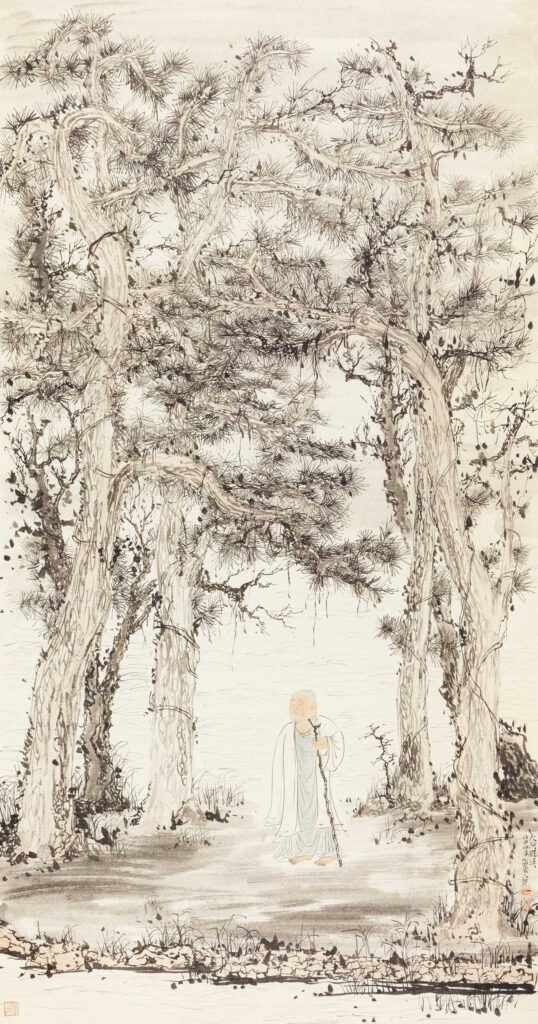
Hidden Traces of Lakes and Mountains 湖山隐迹
——The Landscape ‘Mountain/Water’ 山水 and Culture of the West Lake, (Summer, 2013) Talk given at the Center for Chinese Culture, Paris, France
——西湖的山水与文化,巴黎中国文化中心
Translated by; Michael Cavayero
Some Notes:
On the culture of “yǐn” 隐, meaning: hidden, secret, private, concealed—also meaning a kind of hermitic pilgrimage or retreat into the wilderness or life of solitude:
Historically, in China, obtaining an official position was one of life’s most important goals. However, for many, such a path was impossible to achieve. In ancient China, once this path became closed off to an individual, life would present that individual with a different option or experience. This is called “yǐn,” and this existential expression, state of mind or understanding, slowly became a culture. In the yin culture, everything is seen as transient and empty, even fame and fortune. Finally, in the end, all returns to dust! In China, the concept, culture, and spirit of yin mainly developed because of such conditions. However, once the yin lifestyle developed into a recognized cultural presence in China, its existence flourished and became something positive. Those who practiced a yin lifestyle perhaps hid in the mountains and forests or in the city. Maybe they hid in activities of Calligraphy and painting or by living peripatetically. In general, those who sought yin or the reclusive life had no fixed place and presented a free state of being.
In China, those who attain a higher level of consciousness or enlightenment are referred to as ‘Men of Dao 道. Their starting point always begins with yin or this expression of retreat and solitude. In China, we call this state of mind ‘to see clearly through the mortal life.’ This is an idiom also used by many Buddhist monks. Those who achieve this type of consciousness or practice place themselves at an extreme. Thus they achieve great wisdom; enlightenment.
The Landscape (Mountain and Waters)
This is the city where I live —— Hangzhou!
I call it a city where you can live in yin or seek such a state of mind. In the south of China, the landscape is poised and graceful; it has the reputation of being heaven on earth. Hangzhou was once was the ancient capital of China during the Southern Song dynasty. Today, it is no longer the centre of China’s political culture; it is also not China’s leading business centre. It is far away from politics. Today, there are many cities in China, far away from the political centre. However, there is only one city that has the West Lake 西湖, which is Hangzhou.
Hangzhou has a profound cultural history. It is endlessly flourishing. Once serving as China’s ancient capital in the Southern Song Dynasty, it is a microcosm, a ‘heaven on Earth’. The West Lake is its emblem. Today the West Lake is still that same vision as it was during the Southern Song Dynasty. We can see this from the painting by Li Song李嵩 West Lake 《西湖图》. He painted the West Lake surrounded by mountains on three sides, and today it is just the same.

The China Academy of Art – Qingbo Bridge Studio
中国美术学院 – 清波桥画室
This place is quiet and beautiful beyond words. Its beauty is penetrating. When people visit this studio, they become deeply awed. I don’t know how I have such an affinity to work here. I also don’t know what the future will bring……
Du Rusong 杜如松, is a Flutist with a magnanimous, heroic spirit. Masterful with the flute, he plays, The Partridge Bird Flies《鹧鸪飞》. He has unique talent. One day he came to visit me and told me this sentence:
I lived in the remoteness of the Qiantang River and its blissful open feeling,
I stared into the mountain and heard the spring, the sound of its tide,
All day I did nothing,
The moon came down, the clouds draped upon the sky and sounded with a smile.
幽居钱塘惬野情
观山听泉海潮音
终日无事弄一管
月下披云笑一声
I was incredibly moved. I could feel the sentence. It was an expression of high resonance; also, it possessed the feeling of a painting.
Because of this, I decided I wanted to create Qian Tang River Seclusion
《钱塘幽居图》 just to join in on the fun and excitement of Du’s flute music. After about several months, my former senior classmate, Yan Shanchun 严善醇, came to Hangzhou and wanted to do a brush and ink project that could be passed on and exhibited. Thus we came up with the idea to do a big painting, 250 cm by 1200 cm, about ten large screens in total. One day I would paint on the wall and look and it. It had a vast and wide quality stretching far into the distance, a solid and expressive power. My close friend Fan Yimin 范一民 came over one day and gasped at its ‘big sight’大观. Thus the painting’s name became The Great Sight of Qian Tang River 《钱塘大观图》

Ling Yin Monastery
灵隐寺
During the Southern Song dynasty on one side of the West Lake was an exquisite court life and bustling residential district; on the other side, were faintly discernible Daoist temples and Buddhist monasteries. During that period Hangzhou was known as the “Buddhist Center of the Southeast.”东南佛国.
济公 Ji Gong
The work started in 2009/10/12. After two years of research and production on Ling Yin’s Daoji Ji Gong Hall mural project 灵隐寺济公殿壁画创, on 2011/9/7, the first stage of production was complete. Thus we began the process of installing and opening the project up to the public. The 18 murals are 3.16 meters high and nearly 2.8 meters wide, and the total length of the 18 murals connected together is 50 meters.

Tianmu Shan (Heaven’s Eye Mountain) 天目山
The flourishing of ‘Chan painting’ 禅画 has a very close connection to the West Lake. The Southern Song dynasty’s Mu Xi 牧溪 is the main representative painter of the Liu Tong Monastery School 六通寺画派.

Those enlightened men, in China we refer to them as ‘Men of ‘Dao’道人. They begin by choosing the path of yin. In China, we refer to this state of mind as ‘seeing through the world of the mortals’看破红尘. One places oneself in a position of ‘otherness’ and attains wisdom from this.
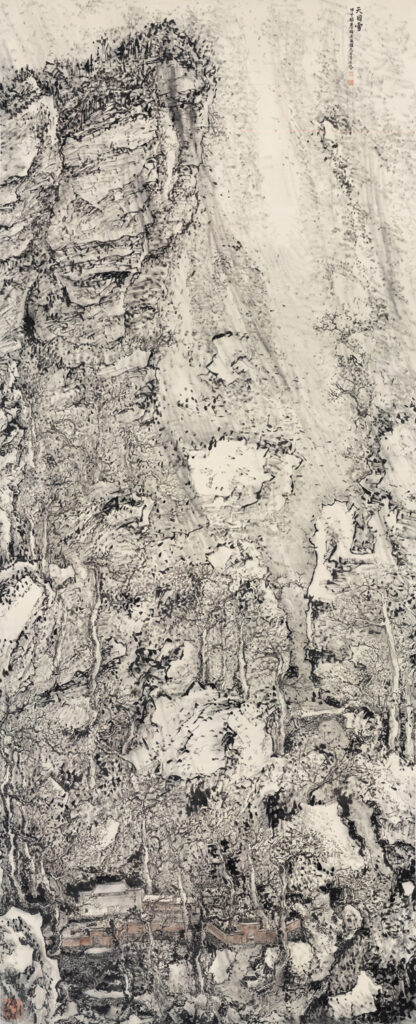
Professor Lin Haizhong discusses his love for the practice of traditional Chinese landscape painting during his visit to Potsdam, New York in the spring of 2012
Read the full magazine


